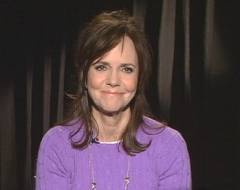Share This Article:
Return to Silver Screen Central Home page


Hello, my name is Sally Field
B+ It’s hard to believe, but it’s been almost a quarter of a century since either film or TV audiences have caught a glimpse of that bright Sally Field smile. Finally, after years of acclaimed but somber roles, the vivacious Field of old re-emerges in Hello My Name Is Doris. All it took was a romance with a man three decades her junior.
In Hello My Name Is Doris, Field plays the title character, a 60ish woman whose entire life was devoted to caring for her now deceased mother. But a chance kind word and a smile from John (Max Greenfield), her company’s new art director, leads to Doris developing a huge crush on the younger man. Soon, an actual friendship develops between the two, and Doris comes out of her lifelong shell, to the dismay of her friend Roz (Tyne Daly), who sees where Doris’ infatuation is heading.
In the wrong hands, Hello My Name Is Doris could easily have become either a more extreme version of The Graduate or a pathetic tragedy. However, director Michael Showalter, who also co-wrote the screenplay, takes care to balance dramatic scenes with those showing the originally neurotic, withdrawn Doris gaining confidence. Early in the movie, Showalter uses the device of having Doris attend a self-improvement seminar whose instructor (Peter Gallagher) gives her the boost she needs to pursue John, but what the director really uses are the considerable talents, both comic and dramatic, of Sally Field. Hello My Name Is Doris has a few hilarious scenes, including Doris’ stint as an album cover girl for a group called Baby Goya and the Nuclear Winters, but it’s mostly a matter of Field turning on her long dormant, infectious charm to credibly become a part of John’s equally younger circle of friends. Showalter stumbles occasionally, especially at the finish line, but frankly, any writer or director would have had trouble crafting an ending of this film that worked dramatically and maintained any semblance of credibility. But Hello My Name Is Doris is an extreme rarity nowadays, a charmingly enjoyable coming-of-age movie for a character—and an actress—whose time had seemingly come and gone.
Continue reading on Hello My Name Is Doris: Mini-review


Recent Comments